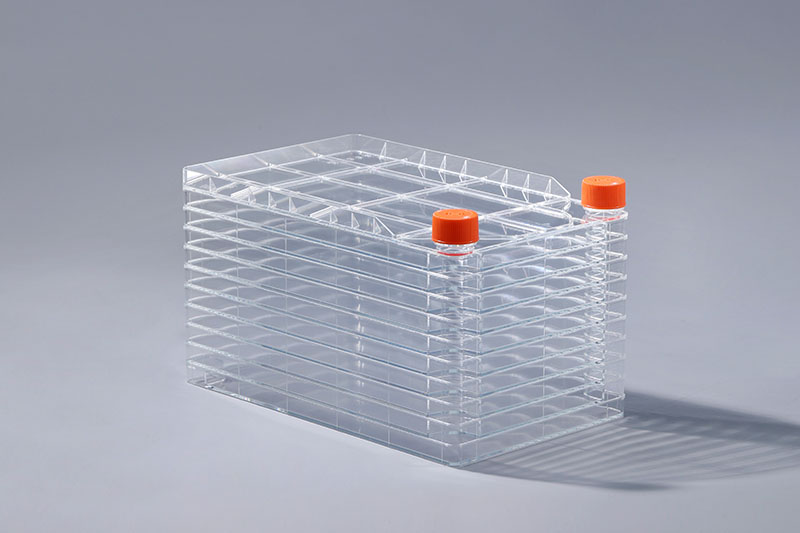जैव प्रौद्योगिकी के निरंतर नवाचार और तेजी से विकास के साथ, पुनर्योजी चिकित्सा और सेल थेरेपी ने विस्फोटक वृद्धि का अनुभव किया है, और बड़े पैमाने पर सेल संस्कृति प्रौद्योगिकी परिपक्व होती रही है। उनमें से, cell factory बड़े पैमाने पर सेल कल्चर में आमतौर पर इस्तेमाल किया जाने वाला उपभोज्य है, और इस सेल कल्चर पद्धति के लिए आमतौर पर शेकर की सहायता की आवश्यकता होती है। CHO, Vero, MRC-5, 2BS, 293T, L929 और मानव द्विगुणित कोशिकाएं शामिल हैं। इन कोशिकाओं का उपयोग मुख्य रूप से एरिथ्रोपोइटिन, मोनोक्लोनल एंटीबॉडी तैयारी, वैक्सीन उत्पादन और अन्य उत्पादों में किया जाता है। इन विट्रो में पशु कोशिकाओं के बड़े पैमाने पर संवर्धन के लिए कृत्रिम रूप से निर्धारित तापमान, आर्द्रता, पीएच और घुलित ऑक्सीजन की स्थितियों के तहत सेल कल्चर कंटेनरों में उच्च घनत्व वाले बड़े पैमाने पर उत्पादन की आवश्यकता होती है। अंतरिक्ष को बचाने, श्रम इनपुट को कम करने और प्रदूषण से बचने की विशेषताएं, और धीरे-धीरे वैज्ञानिक अनुसंधान संस्थानों और दवा कंपनियों द्वारा इसका समर्थन किया जाता है। आम तौर पर, सेल कारखानों में बड़े पैमाने पर उत्पादन के लिए एक प्रकार के बरतन की मदद की आवश्यकता होती है। ऐसा इसलिए है क्योंकि बड़े पैमाने की संस्कृति में कंटेनरों की कई परतें होती हैं। एक प्रकार के बरतन का उपयोग करना तरल खिला, सेल मिश्रण, और पाचन और संस्कृति के दौरान प्रवाह जैसे संचालन के स्वचालन का एहसास कर सकता है। और उच्च दक्षता, भारी मैनुअल संचालन और मानवीय कारकों के कारण होने वाली त्रुटियों को कम करना। इसलिए, बड़े पैमाने पर संस्कृति के लिए सेल कारखानों का उपयोग करते समय, आमतौर पर संस्कृति दक्षता में सुधार करने और सेल संस्कृति की सुचारू प्रगति सुनिश्चित करने के लिए एक प्रकार के बरतन का उपयोग किया जाता है।
At present, common large-scale cultured animal cells include CHO, Vero, MRC-5, 2BS, 293T, L929 and human diploid cells. These cells are mainly used in erythropoietin, monoclonal antibody preparation, vaccine production and other products. The large-scale culture of animal cells in vitro requires high-density mass production in cell culture containers under the conditions of artificially set temperature, humidity, pH and dissolved oxygen.
Among many large-scale culture methods, cell factories have the characteristics of saving space, reducing labor input, and avoiding pollution, and are gradually favored by scientific research institutions and pharmaceutical companies. Generally, large-scale production in cell factories requires the help of a shaker. This is because there are many layers of containers in large-scale culture. Using a shaker can realize the automation of operations such as liquid feeding, cell mixing, and digestion and effluent during culture. and high efficiency, reducing errors caused by heavy manual operations and human factors.
In addition, the use of a shaker can play a role in mass transfer, which is conducive to the sampling and determination of different parameters. Therefore, when using cell factories for large-scale culture, a shaker is generally used to improve the culture efficiency and ensure the smooth progress of cell culture.
The FAI climbed 5.9 percent year-on-year in the first 11 months of 2018, quickening from the 5.7-percent growth in Jan-Oct, the National Bureau of Statistics (NBS) said Friday in an online statement.
The key indicator of investment, dubbed a major growth driver, hit the bottom in August and has since started to rebound steadily.
In the face of emerging economic challenges home and abroad, China has stepped up efforts to stabilize investment, in particular rolling out measures to motivate private investors and channel funds into infrastructure.
Friday's data showed private investment, accounting for more than 60 percent of the total FAI, expanded by a brisk 8.7 percent.
NBS spokesperson Mao Shengyong said funds into weak economic links registered rapid increases as investment in environmental protection and agriculture jumped 42 percent and 12.5 percent respectively, much faster than the average.
In breakdown, investment in high-tech and equipment manufacturing remained vigorous with 16.1-percent and 11.6-percent increases respectively in the first 11 months. Infrastructure investment gained 3.7 percent, staying flat. Investment in property development rose 9.7 percent, also unchanged.
 English
English



















































